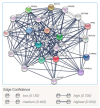Genetics and Extracellular Vesicles of Pediatrics Sleep Disordered Breathing and Epilepsy
- PMID: 31689970
- PMCID: PMC6862182
- DOI: 10.3390/ijms20215483
Genetics and Extracellular Vesicles of Pediatrics Sleep Disordered Breathing and Epilepsy
Abstract
Sleep remains one of the least understood phenomena in biology, and sleep disturbances are one of the most common behavioral problems in childhood. The etiology of sleep disorders is complex and involves both genetic and environmental factors. Epilepsy is the most popular childhood neurological condition and is characterized by an enduring predisposition to generate epileptic seizures, and the neurobiological, cognitive, psychological, and social consequences of this condition. Sleep and epilepsy are interrelated, and the importance of sleep in epilepsy is less known. The state of sleep also influences whether a seizure will occur at a given time, and this differs considerably for various epilepsy syndromes. The development of epilepsy has been associated with single or multiple gene variants. The genetics of epilepsy is complex and disorders exhibit significant genetic heterogeneity and variability in the expressivity of seizures. Phenobarbital (PhB) is the most widely used antiepileptic drug. With its principal mechanism of action to prolong the opening time of the γ-aminobutyric acid (GABA)-A receptor-associated chloride channel, it enhances chloride anion influx into neurons, with subsequent hyperpolarization, thereby reducing excitability. Enzymes that metabolize pharmaceuticals including PhB are well known for having genetic polymorphisms that contribute to adverse drug-drug interactions. PhB metabolism is highly dependent upon the cytochrome P450 (CYP450) and genetic polymorphisms can lead to variability in active drug levels. The highly polymorphic CYP2C19 isozymes are responsible for metabolizing a large portion of routinely prescribed drugs and variants contribute significantly to adverse drug reactions and therapeutic failures. A limited number of CYP2C19 single nucleotide polymorphisms (SNPs) are involved in drug metabolism. Extracellular vesicles (EVs) are circular membrane fragments released from the endosomal compartment as exosomes are shed from the surfaces of the membranes of most cell types. Increasing evidence indicated that EVs play a pivotal role in cell-to-cell communication. Theses EVs may play an important role between sleep, epilepsy, and treatments. The discovery of exosomes provides potential strategies for the diagnosis and treatment of many diseases including neurocognitive deficit. The aim of this study is to better understand and provide further knowledge about the metabolism and interactions between phenobarbital and CYP2C19 polymorphisms in children with epilepsy, interplay between sleep, and EVs. Understanding this interplay between epilepsy and sleep is helpful in the optimal treatment of all patients with epileptic seizures. The use of genetics and extracellular vesicles as precision medicine for the diagnosis and treatment of children with sleep disorder will improve the prognosis and the quality of life in patients with epilepsy.
Keywords: CYP2C19; CYP45; GABA; GABARA; GABARB; GABARC; drug metabolism; epilepsy; exosomes; extracellular vesicles; metabolic function; pediatric; phenobarbital; sleep; sleep disorders.
Conflict of interest statement
The authors declare no conflict of interest.
Figures







Similar articles
-
The Mystery of Red Blood Cells Extracellular Vesicles in Sleep Apnea with Metabolic Dysfunction.Int J Mol Sci. 2021 Apr 21;22(9):4301. doi: 10.3390/ijms22094301. Int J Mol Sci. 2021. PMID: 33919065 Free PMC article. Review.
-
[Development of rapid genotyping methods for single nucleotide polymorphisms of cytochrome P450 2C9 (CYP2C9) and cytochrome P450 2C19 (CYP2C19) and their clinical application in pediatric patients with epilepsy].Yakugaku Zasshi. 2011;131(5):809-15. doi: 10.1248/yakushi.131.809. Yakugaku Zasshi. 2011. PMID: 21532277 Japanese.
-
Genetic profile of patients with epilepsy on first-line antiepileptic drugs and potential directions for personalized treatment.Pharmacogenomics. 2010 Jul;11(7):927-41. doi: 10.2217/pgs.10.62. Pharmacogenomics. 2010. PMID: 20602612
-
Extracellular Vesicles: A Brief Overview and Its Role in Precision Medicine.Methods Mol Biol. 2017;1660:1-14. doi: 10.1007/978-1-4939-7253-1_1. Methods Mol Biol. 2017. PMID: 28828643 Review.
-
The clinical impact of pharmacogenetics on the treatment of epilepsy.Epilepsia. 2009 Jan;50(1):1-23. doi: 10.1111/j.1528-1167.2008.01716.x. Epub 2008 Jul 8. Epilepsia. 2009. PMID: 18627414 Review.
Cited by
-
Astrocytes: GABAceptive and GABAergic Cells in the Brain.Front Cell Neurosci. 2022 Jun 10;16:892497. doi: 10.3389/fncel.2022.892497. eCollection 2022. Front Cell Neurosci. 2022. PMID: 35755777 Free PMC article. Review.
-
Knowledge mapping of exosomes in metabolic diseases: a bibliometric analysis (2007-2022).Front Endocrinol (Lausanne). 2023 May 8;14:1176430. doi: 10.3389/fendo.2023.1176430. eCollection 2023. Front Endocrinol (Lausanne). 2023. PMID: 37223047 Free PMC article.
-
The Mystery of Red Blood Cells Extracellular Vesicles in Sleep Apnea with Metabolic Dysfunction.Int J Mol Sci. 2021 Apr 21;22(9):4301. doi: 10.3390/ijms22094301. Int J Mol Sci. 2021. PMID: 33919065 Free PMC article. Review.
-
Exosomes in brain diseases: Pathogenesis and therapeutic targets.MedComm (2020). 2023 Jun 11;4(3):e287. doi: 10.1002/mco2.287. eCollection 2023 Jun. MedComm (2020). 2023. PMID: 37313330 Free PMC article. Review.
-
Identification of miRNAs in extracellular vesicles as potential diagnostic markers for pediatric epilepsy and drug-resistant epilepsy via bioinformatics analysis.Front Pediatr. 2023 Jul 3;11:1199780. doi: 10.3389/fped.2023.1199780. eCollection 2023. Front Pediatr. 2023. PMID: 37469680 Free PMC article.
References
-
- Luzzi V., Ierardo G., Di Carlo G., Saccucci M., Polimeni A. Obstructive sleep apnea syndrome in the pediatric age: The role of the dentist. Eur. Rev. Med. Pharmacol. Sci. 2019;23:9–14. - PubMed
Publication types
MeSH terms
Substances
LinkOut - more resources
Full Text Sources
Medical

